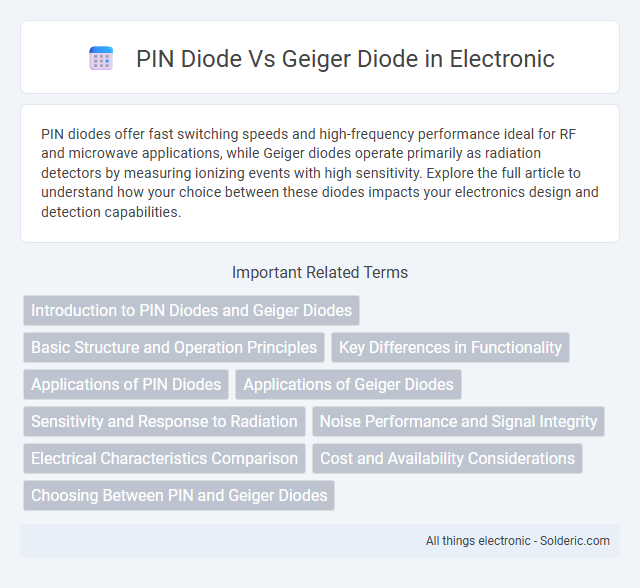PIN diodes offer fast switching speeds and high-frequency performance ideal for RF and microwave applications, while Geiger diodes operate primarily as radiation detectors by measuring ionizing events with high sensitivity. Explore the full article to understand how your choice between these diodes impacts your electronics design and detection capabilities.
Comparison Table
| Feature | PIN Diode | Geiger Diode |
|---|---|---|
| Structure | Intrinsic layer sandwiched between P and N regions | Excessively doped P-N junction designed for avalanche breakdown |
| Operation Principle | Controlled conductivity via intrinsic layer under bias | Detects ionizing radiation via avalanche multiplication |
| Applications | RF switches, photodetectors, attenuators | Radiation detectors, Geiger counters |
| Response Time | Nanoseconds to microseconds | Microseconds to milliseconds |
| Biasing | Forward or reverse biased | Reverse biased near breakdown voltage |
| Sensitivity | Moderate, frequency dependent | High sensitivity to ionizing particles |
| Noise Level | Low to moderate | High due to avalanche process |
| Typical Materials | Silicon, Gallium Arsenide | Silicon |
Introduction to PIN Diodes and Geiger Diodes
PIN diodes feature an intrinsic semiconductor layer between p-type and n-type regions, enabling fast switching and low capacitance, commonly used in RF switching and photodetector applications. Geiger diodes operate in Geiger mode, biased above the breakdown voltage to detect single photons with high sensitivity, ideal for photon counting and low-light detection. Your choice between PIN and Geiger diodes depends on the need for speed, sensitivity, and the specific application in optical communication or radiation detection.
Basic Structure and Operation Principles
A PIN diode consists of an intrinsic layer sandwiched between p-type and n-type regions, allowing it to function efficiently as a variable resistor at RF and microwave frequencies by changing its conductivity with applied bias. In contrast, a Geiger diode is designed for avalanche breakdown operation, featuring a p-n junction that rapidly multiplies charge carriers when a specific reverse voltage threshold is exceeded, enabling detection of single photons or ionizing particles. The PIN diode operates primarily through carrier injection and recombination in the intrinsic region, while the Geiger diode relies on impact ionization and avalanche multiplication for its function.
Key Differences in Functionality
PIN diodes function as variable resistors controlled by current, making them ideal for RF switching and attenuation with fast switching speeds and low distortion. Geiger diodes operate by detecting ionizing radiation, producing a large pulse output only when a particle passage triggers avalanche breakdown, thus serving as highly sensitive radiation detectors. Understanding these key differences helps you select the appropriate diode based on whether your application requires signal control or radiation detection.
Applications of PIN Diodes
PIN diodes are widely used in RF switches, attenuators, and photodetectors due to their ability to handle high-frequency signals and fast response times. Their intrinsic layer provides high resistance in reverse bias, making them ideal for power control and modulation in communication systems. Compared to Geiger diodes, which are specialized for single-photon detection and operate in Geiger mode, PIN diodes offer versatility in analog and digital signal applications across radar, medical imaging, and optical communication technologies.
Applications of Geiger Diodes
Geiger diodes are primarily used in high-speed pulse detection and timing applications due to their ability to operate in the Geiger mode, where they act as sensitive single-photon or single-particle detectors. Their applications include radiation detection in nuclear instrumentation, optical communication systems for photon counting, and lidar technology for distance measurement. Your choice of a Geiger diode is ideal when ultra-sensitive photon detection or precise timing measurements are critical.
Sensitivity and Response to Radiation
PIN diodes exhibit moderate sensitivity and fast response to radiation, making them suitable for detecting high-energy particles with less noise. Geiger diodes offer higher sensitivity and can detect lower levels of radiation but have slower response times and require quenching circuits to reset after each detection. Your choice between these diodes depends on whether you prioritize rapid response or enhanced sensitivity for radiation monitoring applications.
Noise Performance and Signal Integrity
PIN diodes exhibit low noise characteristics and high signal integrity, making them ideal for RF switching and attenuator applications. Geiger diodes generate significant noise due to avalanche multiplication, which can degrade signal quality in sensitive detection systems. Your choice should consider that PIN diodes provide cleaner signals, while Geiger diodes prioritize high sensitivity despite increased noise levels.
Electrical Characteristics Comparison
PIN diodes exhibit low capacitance and high reverse breakdown voltage, enabling efficient RF switching and attenuation, whereas Geiger diodes operate primarily in avalanche mode with a high gain and rapid response ideal for photon detection. The PIN diode's intrinsic layer provides a wide depletion region, resulting in slower response times but higher power handling compared to the Geiger diode's thin junction optimized for single-photon sensitivity. Electrical characteristics such as forward resistance, reverse recovery time, and noise figures differ significantly, with PIN diodes favoring linear applications and Geiger diodes excelling in high-sensitivity, low-light detection scenarios.
Cost and Availability Considerations
PIN diodes generally offer lower cost and wider availability due to their established manufacturing processes and extensive use in RF and microwave applications. Geiger diodes tend to be more expensive and less readily available because they are specialized components used primarily in radiation detection and high-energy physics. When selecting components, your budget and supply chain reliability should guide whether a cost-effective PIN diode or a niche, higher-priced Geiger diode is the better choice.
Choosing Between PIN and Geiger Diodes
Choosing between PIN and Geiger diodes depends on your application's requirements for sensitivity and response time; PIN diodes offer fast switching and low noise, ideal for high-frequency and RF applications. Geiger diodes provide high sensitivity in photon detection through their avalanche mode operation, making them suitable for low-light sensing and single-photon counting. Your selection should balance factors like gain, noise characteristics, and operating voltage to optimize performance in your specific use case.
PIN diode vs Geiger diode Infographic

 solderic.com
solderic.com